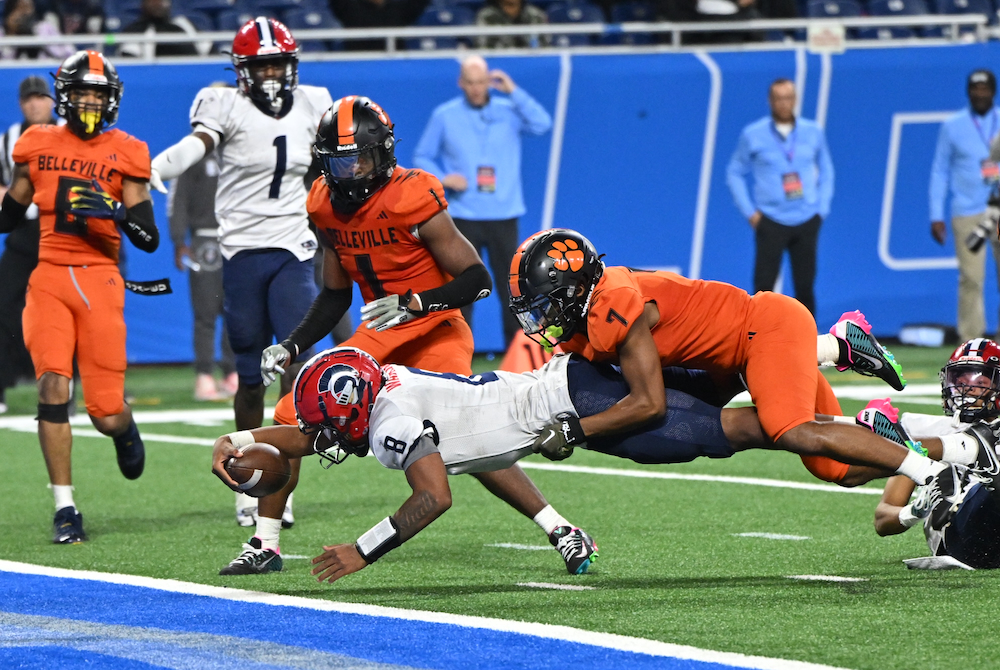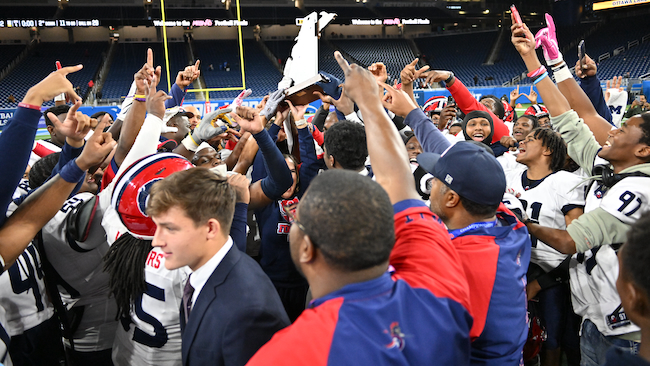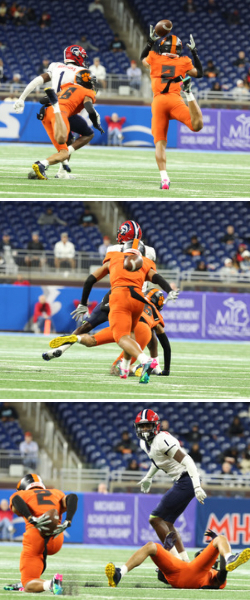
Inside Selection Sunday: Mapnalysis '13
October 28, 2013
By Geoff Kimmerly
Second Half editor
At the end of the day – Sunday, in this case – the 2013 MHSAA football playoff field was determined based on a set of numbers we began working with long before the first kickoff of this season.
So to kick off our discussion of how some of the 2013 playoff-selection decisions were made, here are a few numbers that might boggle the mind – or at least surprise:
- A total of 3,111 high school results were used in determining this season’s field – 2,978 for 11-player and 133 for 8-player games.
- We inputted and then followed the schedules for 623 MHSAA teams.
- We also inputted and followed weekly the schedules for 50 teams from surrounding states and Ontario that played at least one game against one of our MHSAA schools.
- We worked through complicated maneuverings made necessary by seven teams playing a mix of 11 and 8-player games, plus two more teams that played a mix of varsity and junior varsity opponents.
- And by Sunday morning we ended up with a few more numeric rarities: only 225 automatic qualifiers, the fewest since the current playoff system was introduced in 1999, and also an uneven number of at-large bids from our four classes because only six Class D teams reached the number of victories needed to be considered. (This was balanced by taking more at-large qualifiers from Classes A, B and C.)
And that was just the start of one of our most exciting days of the school year.
Following are more details. First, I explain some of the history of the MHSAA playoffs – I’ve lifted this in part from our 2012 report, so skip ahead if you’ve already got that down. Next, I touch on five themes that emerged as we built the brackets for this season’s tournament.
The process
Our past: The MHSAA playoff structure – with 256 teams in eight divisions, and six wins equaling an automatic berth (or five wins for teams playing eight or fewer games) – debuted in 1999, as mentioned above. An 8-player tournament was added in 2011, resulting in nine champions total when November is done.
That’s a long way from our start. The first playoffs were conducted in 1975 with four champions. Four more football classes were added in 1990 for a total of eight champions each fall. Through 1998, only 128 teams made the postseason, based on their playoff point averages within regions (four for each class) that were drawn before the beginning of the season. The drawing of Districts and Regions after the end of the regular season did not begin until the most recent playoff expansion.
In early years of the current process (or until the middle of the last decade), lines were drawn by hand. Dots representing qualifying schools were pasted on maps, one map for each division, and those maps were then covered by plastic sheets. Districts and Regionals literally were drawn with dry-erase markers.
Our present: After a late Saturday night tracking scores, we file in as the sun rises Sunday morning for a final round of gathering results we may still need (which can include making a few early a.m. calls to athletic directors). Then comes re-checking and triple-checking of enrollments, what schools played in co-ops, some records and more before the numbers are crunched and the fields are set.
Those 256 11-player teams are then split into eight equal divisions based on enrollment, and their locations are marked on digital maps that are projected on wall-size screens and then discussed by nearly half of the MHSAA staff plus a representative from the Michigan High School Football Coaches Association. Only the locations themselves are marked (by yellow dots) – not records, playoff point averages or names of the schools or towns. In fact, mentions of those are strictly prohibited. Records and playoff points are not part of the criteria. Matchups, rivalries, previous playoff pairings, etc. also DO NOT come into play. The same process is followed for organizing the 8-player bracket.
Observations and answers: 2013
This doesn’t happen overnight: Preparation for selecting the MHSAA playoff field begins long before the first kickoff of fall, much less the first practice. We load schedules for all 600-plus varsity teams during the summer, and many schedules remain fluid right up until the first Friday of the season – and this fall, a few weren’t settled until Week 2 or 3.
This summer as in some past we also worked through schools closing (Inkster, Saginaw Buena Vista, Detroit Northwestern, Flint Northern), and others deciding in mid-July and early August they would not field teams because of a lack of players.
Sometimes we have to take odd paths to find scores for these games. The last 11-player score to be added to our data this regular season came in as a result of tweeting the sports anchor of a Wheeling, W.Va., television station. Our last 8-player score came in via email from a Wisconsin athletic director at 10:30 Saturday night. Thankfully, we get plenty of assistance from some of our friends in the field, who keep an eye on the data and alert us when something appears missing or incorrect.
Win and advance: This season’s list of 5-4 teams includes a number of heavy hitters that did not receive at-large bids – East Grand Rapids, Utica Eisenhower, Orchard Lake St. Mary’s and Flint Powers Catholic to name a few. All were solid teams and played strong competition. All missing the playoffs likely raised some eyebrows.
But we have to take a look at this from a statewide view. There admittedly can be some argument about what schools qualified for the 226-256 spots in the field – but the important part is that 225 qualified because they all met the minimum win requirement. A playoff is simply that – it decides a champion based on teams winning. For some it’s harder to pile wins, of course, because they play in tough leagues. But the winners of those leagues are in the field – and surely will credit that tough road with getting them prepared to now play the state’s best.
Geography rules: This long has been rule number one for drawing MHSAA brackets in any sport, and is a repeat as well for those who have read this report the last two Octobers. Travel distance and ease DO come into play. Jumping on a major highway clearly is easier than driving across county-wide back roads, and that’s taken into consideration.
Also, remember there’s only one Mackinac Bridge and hence only one way to cross between peninsulas – and boats are not considered a possible form of transportation. When opponents from both peninsulas will be in the same District, distance to the bridge is far more important than as the crow flies.
The best example of this comes this season in Division 5. Grayling clearly is east of both Kingsley and Kalkaska – but also sits on I-75, while those two do not. So while those more western teams are geographically closer to Houghton, Menominee and Kingsford from the Upper Peninsula, we instead paired the three U.P. teams with Grayling because being on a main highway made for a shorter trip. The trip to Grayling for any of those U.P. teams would be 36 miles shorter to Grayling than Kingsley and 13 miles shorter to Grayling than Kalkaska.
Sometimes it’s where the points aren’t: Sure, it would be best-case scenario to have perfect sets of eight dots split into four quadrants from Calumet to Bedford. But generally that doesn’t occur. “Dots determine the map” is a common phrase heard here during this selection process, but that works the other way as well. If there are no qualifiers in a division from a specific area of the state – see Division 1, with none south of Holland or west of the greater Lansing area – there’s no choice but to create the unusual Regional Final possibility of Traverse City West vs. Brighton. Brighton is simply closer to the west side of the state than our other options.
Border to border vs. coast to coast: Should Regions be grouped north to south or east to west? There isn't a right or wrong answer – it just depends on that set of dots.
Whenever we have Upper Peninsula teams in a division, they’ll be grouped with those from the northernmost points of the Lower Peninsula for a District. The next northernmost schools will be grouped into a District, and together those eight will form a Region.
But the tough decision comes with the other six Districts. Look at this season’s Division 5 map: Six Districts are grouped south of U.S. 10 with three near or west of U.S. 127 and three east of that highway, which runs through the center of the Lower Peninsula. We grouped the two southwestern Districts into a Region and the two southeastern Districts into a Region – leaving a final Region that stretches from Muskegon on Lake Michigan to Almont, about 35 miles west of Lake Huron.
That’s a haul. But it’s also the best of our possible compromises. We could’ve instead paired regions that would’ve stretched from Hopkins to Monroe – only 19 fewer miles in distance than Muskegon Oakridge to Almont, but a scenario that could’ve created travel increases for a number of additional teams. Another option included a possible trip from Detroit University Prep to Freeland, which also would take more than two hours.
Bottom line – it’s been written here before – we pour all we have into this process, asking questions often more than once until we come up with a consensus. We do appreciate the arguments that arise once brackets are released to the public: The discussions are proof of how much players, coaches and fans care – and often show us new ways we can look at a system that’s now 15 years old.
But we must remember that the good news is the tournament is still set up to reward nine champions over the next five weeks, and five schools – Auburn Hills Oakland Christian, Coldwater, Detroit Allen, Eaton Rapids and Muskegon Mona Shores – will be competing for those titles for the first time.
It’s not so much how the tournament starts as how it ends. And we’re preparing for nine more memorable conclusions.
PHOTO: Each collection of grouped dots is a District on this season's Division 3 playoff map.

Southfield A&T, Marshall End Belleville's 2-Year Reign with 1st Finals Championship
By
Paul Costanzo
Special for MHSAA.com
November 27, 2023
DETROIT – Isaiah Marshall took a second Sunday night to think about the interception he’d just thrown that led to Belleville taking a late lead in the Division 1 Football Final.
But just a second.
When Marshall and his Southfield Arts & Technology teammates took the field down four points with 4 minutes, 47 seconds remaining at Ford Field, the interception wasn’t on his mind. Neither was the raucous Belleville crowd that had awoken on the home side of the stadium.
He wasn’t thinking about stopping a three-peat or snapping a 38-game Belleville win streak. He wasn’t thinking about the talk he’d heard during the week leading up to the game, that his team was on its way to getting blown out like so many of those previous 38 opponents.
All Marshall was focused on was doing his job.
“As soon as I threw the pick, I knew what I had to do differently,” Marshall said. “I just wasn’t thinking about that last play. As soon as I threw the pick, I just thought about it on the bench, then as soon as I came out, it wasn’t on my mind at all. I just knew I had to go down the field and score.”
Like he had all night, Marshall came through when the Warriors needed him most, leading his team on a 69-yard scoring drive, finishing the final 11 with his legs for the go-ahead score in Southfield A&T’s 36-32 victory against Belleville.
 His defense finished the rest, as Dorian Freeman intercepted a pass during the final seconds, sealing the first Finals title for Southfield.
His defense finished the rest, as Dorian Freeman intercepted a pass during the final seconds, sealing the first Finals title for Southfield.
“It’s special,” A&T coach Aaron Marshall said. “It’s special for the community. It’s a long time coming. All week I’ve been getting calls from guys I’ve never met just congratulating the boys on making it. We had never even made it to the championship game, let alone won one. It’s real big for the community. I’m really proud.”
To do it, the Warriors needed to overcome the team that has dominated Division 1 for the past three seasons in Belleville (13-1). The Tigers had won the past two Division 1 Finals, and hadn’t dropped a game since Sept. 10, 2021.
They entered Sunday having outscored opponents this fall by an average of 49-7. They also featured the nation’s No. 1 recruit in the Class of 2025 in quarterback Bryce Underwood.
But Sunday, none of that mattered to Marshall and the Warriors (13-1). Well, except maybe the last part.
“Just a little bit,” Marshall said when asked if he was out to prove he was the state’s top quarterback. “I do think I’m the best player in the state. Me proving that tonight, and showing what I can do on the big stage shows that, I think.”
He finished the night completing 20 of 31 passes for 281 yards with two touchdowns, as well as two interceptions. He also rushed for 134 yards and the go-ahead score, as well as the two-point conversion that put his team up four.
“He came out there and played like I thought he was going to play,” said Belleville star linebacker and running back Jeremiah Beasley, who has committed to Michigan. “He’s a real tough player. Since we were little, he’s always been tough. He came out there and played with all his heart, and they came out on top.”
Underwood certainly had his moments, finishing 11 for 24 for 164 yards and a touchdown to go along with one interception. He also had five rushes for 39 yards.
And A&T was certainly cognizant of what Underwood could do, especially when he got the ball back with 47 seconds to play and a chance to take the lead. But by playing coverage, they didn’t allow the Tigers to push the ball down the field, and eventually pressure from senior defensive tackle Reggie Gardner forced the throw that Freeman intercepted to clinch the game.
 “My coaches just told me to spy the quarterback, and whatever he did, I would go,” Freeman said. “Then it was just right in my zone.”
“My coaches just told me to spy the quarterback, and whatever he did, I would go,” Freeman said. “Then it was just right in my zone.”
A&T led for most of the game, getting a pair of rushing touchdowns from Mathias Davis during the first half, the second score giving them a 12-7 lead.
After a 31-yard field goal from Belleville’s Brayden Lane made the score 12-10, Marshall engineered an 80-yard drive over the final three minutes of the second quarter to give his team a 10-point lead at the half. He accounted for 79 of the 80 yards with either his legs or his arm, finishing it off with a 13-yard TD pass to Tashi Braceful with 13 seconds remaining in the half. Braceful finished the night with 10 catches for 152 yards.
The Warriors nearly added to that halftime lead, as well, recovering a squib kick at the Belleville 43. Marshall hit Tyjuan Esper for a 38-yard gain on the next play, but he was tackled as the first-half clock expired.
Early in the third quarter, Marshall and the Warriors did stretch their lead when he threw a 19-yard TD pass to Xavi Bowman on a 4th-and-14. DaMario Quarles’ conversion run put them up 28-10 with 3:39 to play in the third quarter.
Of course, Belleville didn’t go away.
The Tigers responded immediately with a 45-yard TD pass from Underwood to Jalen Johnson. And after stopping Marshall on a 4th-and-2 run near midfield, they needed just three plays and 30 seconds to pull within three points of the lead as Beasley scored on a 15-yard run.
On the next A&T possession, Marquis Peoples put Belleville right back in business with an interception that he returned to the 35-yard line. Beasley again cashed in three plays later, with a 22-yard TD run that gave Belleville a 33-27 lead with 4:47 remaining.
Beasley finished the night with 106 yards and the two touchdowns on the ground.
“He’s a senior ball player; he did exactly what he was supposed to do,” Belleville coach Calvin Norman said of Beasley. “He came through in the clutch. When he ran the ball, he did his thing. I have nothing but love for the young man.”
Belleville cornerback Adrian Walker made one of the more remarkable plays of the weekend late in the first quarter, intercepting a Marshall pass deep in A&T territory.
Walker got both hands on the pass, deflecting it up and toward himself as he was spinning up the field. The ball went over his head and Walker reached behind his back to make the catch at the A&T 26.
Four plays later, Belleville was on the board with a 16-yard Colbey Reed touchdown run, and the Tigers led 7-6.
PHOTOS (Top) Southfield A&T quarterback Isaiah Marshall stretches for the game-winning touchdown during Sunday’s Division 1 Final. (Middle) The Warriors ended the night by raising their first championship trophy. (Below) Belleville’s Adrian Walker (2) makes a stunning behind-the-back interception. (Photos by Hockey Weekly Action Photos.)

